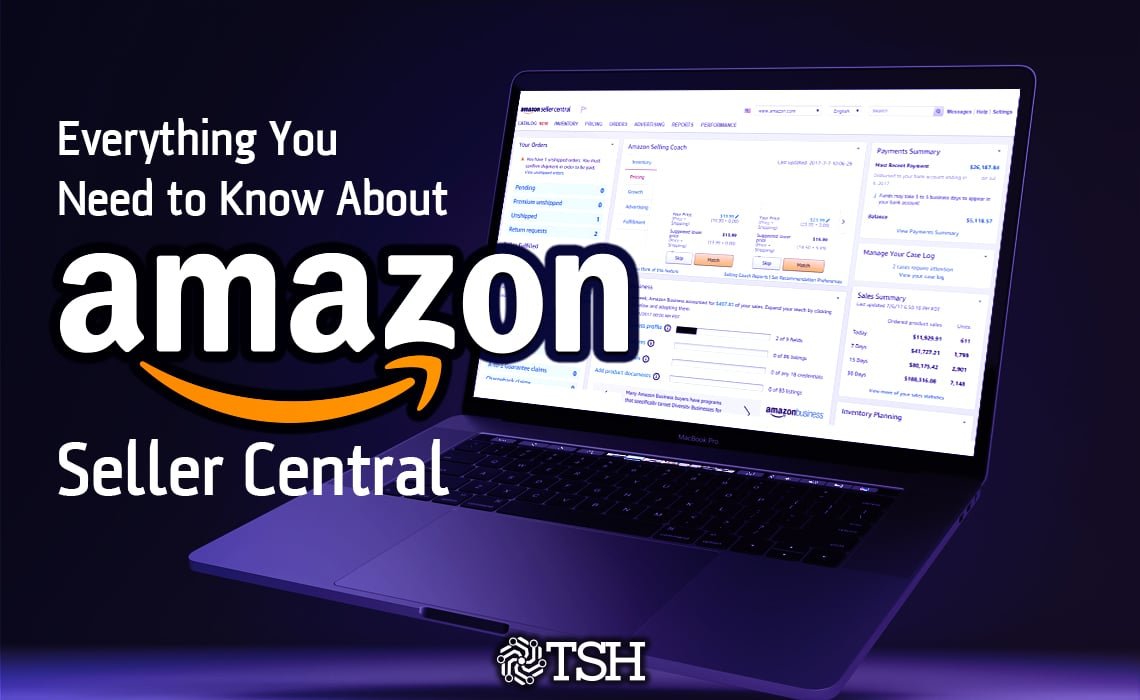Technological advances have altered how we live, work, and shop. These days, you don’t have to physically go to a store to buy items. With just a few clicks on your smartphone, you can order almost anything and have it delivered to your doorstep. Platforms such as Amazon have made shopping highly user-friendly.
Amazon has virtually anything and everything. It began as an online bookstore on July 5, 1994, and has completely transformed the retail world. From selling groceries and electronics, Amazon even offers cloud computing services now. The journey of this small startup turning into a trillion-dollar company is astounding.
If you want to leverage Amazon’s platform to sell your products, you have come to the right place. They dominate e-commerce, and other platforms struggle to compete with their Seller Central. Whether you are a small business owner or a large enterprise, Seller Central provides countless opportunities to help you reach millions of customers worldwide.
This guide offers insight into Amazon Seller Central features, benefits, downsides, and current trends relevant to 2025.
What does Seller Central on Amazon mean?
This is a unique platform for individuals and corporations selling their products to consumers directly on the Amazon marketplace and managing inventory and customer relations as well as sales data. In 2025, AI-powered analytics, advanced advertising services, and support for third-party logistics made Amazon Seller Central more advanced.
When registering with Amazon Seller Central a user can choose between two methods of order fulfillment:
Fulfilled by Merchant (FBM): You manage the complete order fulfillment cycle, including storage, packaging, shipping, and customer support. This option offers more control of customer satisfaction, however, it is often very time and resource-consuming.
Fulfilled by Amazon (FBA): Amazon manages to sell account customer orders to be managed as stored, packaged, shipped, and serviced on the seller’s behalf. This option maximizes seller access to Amazon’s logistical services and helps boost sales by intending customer orders from Prime-eligible accounts.
In 2025, Amazon has added new fulfillment options like FBA Local, which enables sellers to keep inventory in local warehouses for quicker delivery. There’s also FBA Green, which utilizes eco-friendly packaging materials and carbon-neutral shipping as a sustainable option.
The Pros of Amazon Seller Central in 2025
Amazon Seller Central still provides a wealth of advantages in 2025, as it remains one of the highly preferred platforms for e-commerce businesses. Here are some of the primary pros in 2025:
1. Full Control Over Products
The ability to control product listings is one of the most important features of Amazon Seller Central. As of 2025, the platform has introduced new product catalog management features which makes doing so easier than ever. You can set your prices, write product descriptions, and upload relevant pictures and videos of the products. Moreover, Amazon’s AI tools can assist you with optimizing your listings to increase their visibility and conversion rates.
2. Managing Inventory Efficiently
Keeping track of inventory is one of the most important aspects of managing an online business. Amazon Seller Central outperforms its rivals on this front. By 2025, the platform will be equipped with Smart Inventory and other AI tools, allowing sellers to monitor stock levels in real-time, set automated reorder reminders, and analyze sales trends to forecast demand. Artificial intelligence is also investing in inventory remediation loans which enables sellers to stop running modifying sales and drinking problems.
3. Gaining Access to Sophisticated Analytic Tools
In e-commerce, data is one of the most important things used, and it’s especially important for those who do business on Amazon Seller Central. By 2025 the platform is no longer limited compared to its competitors because of its upgraded analytics dashboard, which now includes AI tools that can provide relevant insights regarding customer behavior, participated sales, the economy, and more. Not only can these assist sellers develop appropriate strategies to further maximize their profit, but also Amazon’s Predictive Analytics function will enable sellers to change their business plan in anticipation of increasing sales.
4. Global Reach
With Amazon’s global marketplace, sellers can sell products to customers in over 180 countries. As of 2025, selling programs have been made easier for international sellers, as now sellers can list their products to several marketplaces at once. These programs also include translation and localization features that allow sellers to customize their listings for various regions. With Amazon’s Global Selling Assistant, sellers can streamline the management of international operations from a single dashboard, making global commerce effortless.
5. Enhanced Advertising Tools
Further, Amazon’s advertising platform has grown to be a key asset to sellers looking to increase their visibility and sales. With the new features added as of 2025, sellers can benefit from AI-Powered Ad Optimization, which alters advertising campaigns in real time for the best performance. In addition, the platform provides advanced ad targeting capabilities through which sellers can target users based on demographics, shopping, and buying behaviors.
6. Prime Eligibility
Customers who shop on Amazon often select the Prime option, with free and fast delivery available. In 2025, membership always appears to exceed 300 million people from all around the globe, which serves as a great advertising platform for sellers to tap into a loyal and big-spending customer pool. Furthermore, Amazon kicked off selling for Prime members only through seller’s discount offers. This initiative boosts sales further.
Disadvantages of Amazon Seller Central in 2025
No doubt that Amazon Seller Central has numerous advantages, but it also has its share of challenges. Here is a list of some of the disadvantages sellers may face in 2025:
1. Additional Fees
Undoubtedly the most important problem when selling on Amazon is the fees. Since 2025 Amazon’s fee policies have become more sophisticated, having added fees for storage, fulfillment, and advertising. While FBA appears to be appealing, it may be too expensive for sellers who have low-margin products. On top of that, Amazon’s referral fees, a percentage of your sale, add to your hardly any money left.
2. Other Firms Selling on Amazon
Amazon’s marketplace is its most competitive area with millions of sellers competing for a customer’s attention. As years go by in 2025, competition has risen and it is more difficult for new sellers to make a name for themselves. To be successful, sellers must spend money on advertising, and optimize their listings, and with the highly competitive marketplace, they must have a low price as well. In addition, the formerly simple Buy Box that winners are awarded has garnered more competition due to the Amazon algorithm buying box. These have advanced because sellers who are more established and bigger are preferred.
3. Third-Party Amazon Dependants
Amazon is not a good platform to build your e-commerce business around because it is very limiting. By the time we reach 2025, all that can change depending on new policies and algorithms along with your sales changing instantaneously. Anything from account suspension to search algorithm changing can hurt revenue. To counter this, sellers are shifting their shops to different platforms other than Amazon. Platforms like Shopify, eBay, and Walmart are becoming more and more popular.
4. What Customers Expect
Previously, amazon maintained strict standards for customer service and sellers had to comply with those standards. For the year 2025, customers expect rapid shipping, simple return policies, and helpful customer interaction. If these criteria are not met, sellers run the risk of receiving negative reviews which can damage the seller’s reputation as well as sales. In addition, the A to Z guarantee offered by Amazon does a great job protecting clients, however can also cause friction that sellers will have to deal with.
New Fads for Amazon Seller Central in 2025
With the advancement of technology, a variety of activities are accompanying the adoption of advanced technology that will change the future of Amazon Seller Central. These are some trends you should not miss in 2025 along with the technology’s functions:
1. AI and Machine Learning
AI and machine learning are becoming more common in e-commerce. Sellers have told us about innovations that Amazon will add when mid-2025 comes, claiming that AI will be working on almost every feature of the seller central accounts including automating advertisements, inventory control systems and managing sales. Sellers will have AI tools that will help them improve product descriptions, estimate sales, and handle clients automatically.
2. Sustainability
Sustainability is another important area of focus for Amazon and its sellers. Sellers are encouraged to adopt eco-friendly practices by initiatives like FBA Green and Climate Pledge Friendly launched by Amazon in 2025. Sellers using sustainable practices like recyclable packaging or carbon-neutral shipping can earn badges to appeal to eco-friendly consumers.
3. Voice Commerce
Sales using voice commands are becoming a significant trend with the increasing popularity of voice assistants like Alexa, and Amazon is no exception. In 2025, Amazon improved how sellers optimize their listings for voice search enabling buyers to make purchases through simple voice commands. Sellers optimizing their listings for voice search will likely benefit from this emerging market.
4. Social Commerce
Amazon integrated more features into their social media account, selling and advertising their products on platforms like Instagram and TikTok. They partnered with these social media platforms to sell through Instagram stories and TikTok ads. In 2025, Amazon leveraged its Live Shopping feature where sellers can engage viewers by demonstrating products live and answering questions about the products.
5. Personal Touch
Based on emerging customer trends, it is evident that personalization will be vital in winning over customers in 2025. Through their proprietary algorithms, Amazon automatically provides product choices based on customer behaviors. Sellers can capitalize on this foresight by incorporating personalized discounts and product bundles.
Closing Remarks
In 2025, Amazon Seller Central continues to be a marketplace with lucrative possibilities not only for sellers but also for those seeking to make use of its wide array of tools and features to navigate the competitive world of e-commerce. Although there are challenges like fees and competition, selling on Amazon is more viable for most sellers than not.
Keeping track of new trends and enhancing your strategies through the sophisticated tools offered by Amazon allows you to maximize sales and grow your business in the leading online marketplace. For professional sellers and novices alike, there is no denying that Amazon Seller Central has untapped potential to help reach millions of customers and achieve e-commerce aspirations.
What are your views on this article? Did it help you understand Amazon Seller Central in 2025? Let us know in the comments below! We would love to hear your stories.



